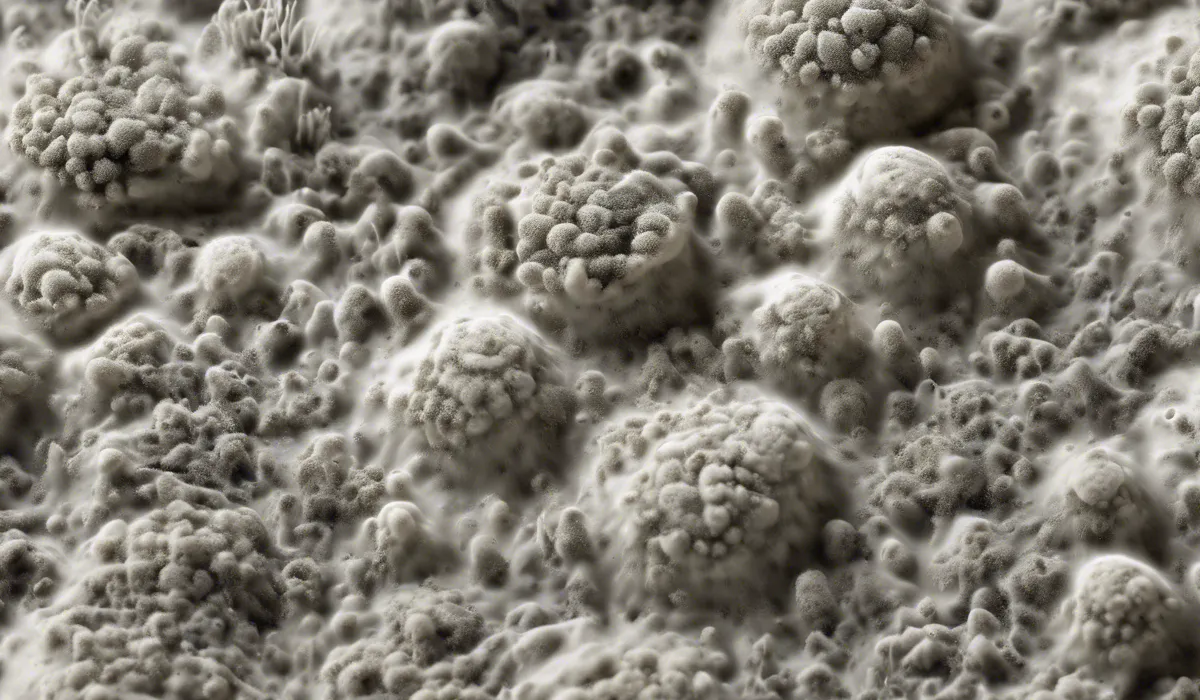Mold spores are typically 3 to 40 micrometers in size. They are small enough to be airborne and invisible to the naked eye. Individual spore sizes vary depending on the mold species.
Understanding Mold Spores: Scale and Differences

What Are Mold Spores?
Mold spores are tiny structures that mold uses to reproduce and spread. These spores are part of the fungus family, like tiny seeds that can grow into new mold when the conditions are right.
Mold can be found almost everywhere in our environment, both indoors and outdoors, and the spores are a natural part of the air we breathe.
Size Comparison to Common Objects
To understand how small mold spores are, let us compare them to things we can see. A human hair is about 70 micrometers wide, so some mold spores are almost half the width of a human hair.
They are also smaller than a grain of sand, which is about 50 to 2,000 micrometers. Mold spores are so tiny that they remain invisible to the naked eye and can only be seen with a microscope.
Size Range of Mold Spores
Mold spores vary in size, typically ranging from 3 to 40 micrometers. Because of their small size, these spores can easily become airborne and move through the air.
When we breathe, these spores can enter our respiratory system without us even knowing it.
Variation Among Different Mold Types
There are thousands of mold species, and each has spores of different shapes and sizes. Some spores are round, while others might be oval or thread-like.
The size and shape of mold spores are important because they can affect how easily the mold spreads and how it affects our health.
Detection and Measurement of Mold Spores

Techniques for Spore Detection
Scientists and professionals use several techniques to find mold spores in the environment.
Air sampling is a common method where air is collected and analyzed to determine the types and amounts of mold present. Surface sampling can also be done by swabbing an area and checking for spores.
Tools for Measuring Spores
Special instruments are used to measure mold spores. Microscopes are essential for seeing the spores, and there are devices like air samplers that capture spores from the environment.
Spore traps and culture plates can help professionals grow and identify molds from different locations.
Challenges in Quantifying Spores
Measuring mold spores is not always easy. Airborne spores are constantly moving and changing in concentration, so results can vary from one sample to another.
Also, different molds require different growth conditions, making it hard to identify all types in a single test.
Health Implications of Mold Spore Size

Spore Size and Air Quality
The size of mold spores matters when it comes to the air we breathe. Small spores can stay airborne longer and travel deeper into our lungs.
This can affect indoor air quality, especially in damp or poorly ventilated areas where mold can grow more easily.
Spore Size and Respiratory Health
When mold spores are inhaled, they can cause health problems, particularly for people with allergies or asthma.
Smaller spores can reach the small airways in the lungs and cause irritation or allergic reactions. It is important to keep indoor environments clean and dry to reduce mold growth and exposure to spores.
Understanding Spore Size for Remediation
Knowing about mold spore size is crucial for mold cleanup and prevention. Professionals use this knowledge to choose the best methods for removing mold and preventing it from coming back.
Keeping humidity levels low, fixing leaks, and using air purifiers can help maintain a healthy indoor environment.
Spore Size in Prevention Efforts
Understanding the size of mold spores also helps in designing buildings and HVAC systems that can better control moisture and filter the air.
This can prevent mold growth and reduce exposure to mold spores, creating a safer and healthier living space for everyone.
FAQs About Mold Spore Size
What is the size range of mold spores?
Mold spores typically range from 3 to 40 micrometers in size.
Can mold spores be seen without a microscope?
No, mold spores are invisible to the naked eye and require magnification to be seen.
Are all mold spores the same size?
No, individual mold spore sizes vary depending on the species of mold.
Can mold spores become airborne due to their size?
Yes, mold spores are small enough to become airborne.
How small is a mold spore compared to common particles like dust?
Mold spores are often smaller than many dust particles, which typically range from about 1 to 100 micrometers in size.
Final Thoughts
Mold spores range from 3 to 40 micrometers, making them airborne particles that escape visibility to the human eye.
The size of a spore can vary significantly across different mold species, which affects how they interact with their environment and the potential for human exposure.
